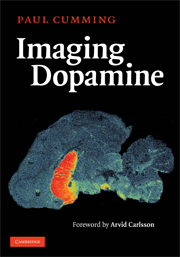Book contents
- Frontmatter
- Contents
- Foreword
- Acknowledgments
- Introduction
- 1 The life history of dopamine
- 2 Enzymology of tyrosine hydroxylase
- 3 The assay of tyrosine hydroxylase
- 4 Enzymology of aromatic amino acid decarboxylase
- 5 PET studies of DOPA utilization
- 6 Conjugation and sulfonation of dopamine and its metabolites
- 7 Dopamine synthesis and metabolism rates
- 8 MAO activity in the brain
- 9 Vesicular storage of dopamine
- 10 Dopamine release: from vesicles to behavior
- 11 The plasma membrane dopamine transporter
- 12 Dopamine receptors
- 13 Imaging dopamine D1 receptors
- 14 Imaging dopamine D2 receptors
- 15 Factors influencing D2 binding in living brain
- 16 The absolute abundance of dopamine receptors in the brain
- 17 Conclusions and perspectives
- References
- Index
- Plate section
6 - Conjugation and sulfonation of dopamine and its metabolites
Published online by Cambridge University Press: 04 December 2009
- Frontmatter
- Contents
- Foreword
- Acknowledgments
- Introduction
- 1 The life history of dopamine
- 2 Enzymology of tyrosine hydroxylase
- 3 The assay of tyrosine hydroxylase
- 4 Enzymology of aromatic amino acid decarboxylase
- 5 PET studies of DOPA utilization
- 6 Conjugation and sulfonation of dopamine and its metabolites
- 7 Dopamine synthesis and metabolism rates
- 8 MAO activity in the brain
- 9 Vesicular storage of dopamine
- 10 Dopamine release: from vesicles to behavior
- 11 The plasma membrane dopamine transporter
- 12 Dopamine receptors
- 13 Imaging dopamine D1 receptors
- 14 Imaging dopamine D2 receptors
- 15 Factors influencing D2 binding in living brain
- 16 The absolute abundance of dopamine receptors in the brain
- 17 Conclusions and perspectives
- References
- Index
- Plate section
Summary
Biochemistry of COMT
COMT catalyzes the transfer of active methyl from S-adenosylmethionine (SAM) to dopamine and other catechols (Axelrod & Tomchick1958). The methylation is preferentially directed to the p-hydroxyl group of most substrates. In the brain, the enzyme exists in two distinct molecular forms: a soluble form with low affinity for catecholamine substrates, and a membrane-bound form with μM affinity with respect to dopamine (Jeffery & Roth 1984). The membrane-bound form can be solubilized with strong detergent, suggesting that it is an integral membrane protein. The activity of both forms is dependent on the presence of Mg2+, and is maximal at pH greater than 7. Mechanistic studies of the membrane-bound form suggest that catalysis is initiated with binding of the co-substrate SAM, followed by the formation of a ternary complex with dopamine. The reaction is inhibited by low concentrations of the end-product S-adenosylhomocysteine (Rivett & Roth 1982). Some biochemical properties of COMT are summarized in Table 6.1.
The membrane-bound form of COMT differs from the soluble form in having an extra 50-residue hydrophobic sequence at the N-terminus (Ulmanen et al. 1997). When expressed in transfected mammalian cells, the membrane-bound COMT is associated with the endoplasmic reticulum and nuclear membranes, but not in the plasma membrane – an indication that its substrates must be present in the cytosol rather than on the external plasma membrane, as was once believed.
- Type
- Chapter
- Information
- Imaging Dopamine , pp. 80 - 84Publisher: Cambridge University PressPrint publication year: 2009



